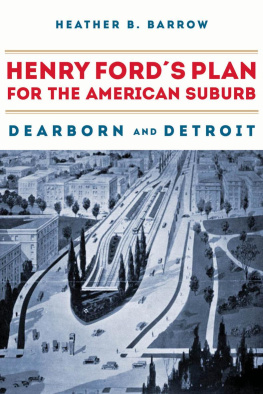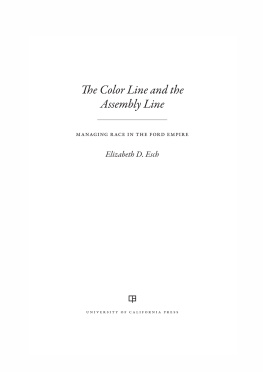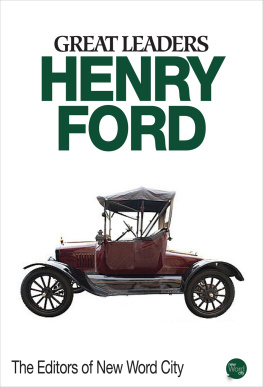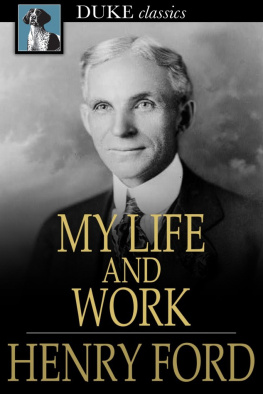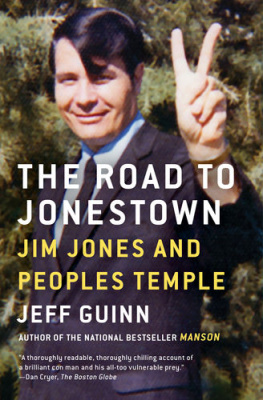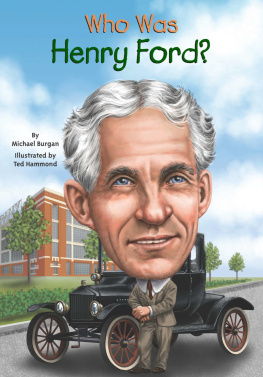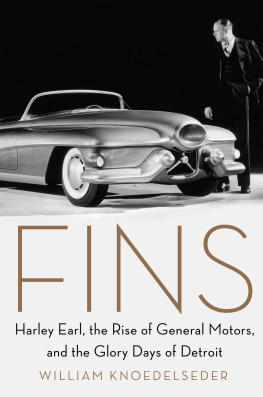HENRY FORDS PLAN
FOR THE
AMERICAN SUBURB
DEARBORN AND DETROIT
HEATHER B. BARROW
NIU PRESS / DEKALB
Northern Illinois University Press, DeKalb 60115
2015 by Northern Illinois University Press
All rights reserved
Printed in the United States of America
24 23 22 21 20 19 18 17 16 15 1 2 3 4 5
978-0-87580-490-3 (cloth)
978-1-60909-180-4 (ebook)
Book and cover design by Shaun Allshouse
Library of Congress Cataloging-in-Publication Data
Barrow, Heather B.
Henry Fords plan for the American suburb : Dearborn and Detroit / Heather B. Barrow.
pages cm
Includes bibliographical references and index.
ISBN 978-0-87580-490-3 (hardback)
ISBN 978-1-60909-180-4 (ebook)
1. Ford, Henry, 18631947. 2. SuburbsMichiganDetroitHistory20th century. 3. SuburbsMichiganDearbornHistory20th century. 4. Cities and townsMichiganGrowthHistory20th century. 5. Detroit (Mich.)Economic conditions20th century. 6. Dearborn (Mich.)Economic conditions20th century. 7. Automobile industry and tradeSocial aspectsMichiganHistory20th century. 8. FordismUnited StatesHistory20th century. 9. United StatesEconomic conditions20th century. I. Title.
HT352.U62D4833 2015
307.7609774'340904dc23
2015006809
I will build a motor car for the multitude.... For the unskilled individual to operate easily.... Built of honest materials... after the simplest designs.... It shall be so low in price that the man of moderate means may own oneand enjoy with his family the blessings of happy hours spent in Gods great open spaces.
Henry Ford, An Ideal Realized, Ford Times
Table of Contents
Illustrations
Figures
FIGURE 1: Map of Detroit and Suburbs
FIGURE 2: Map of Dearborn
FIGURE 3: Map of Village Industries
FIGURE 4: Map of Muscle Shoals, Alabama
FIGURE 5: Photo of Fordlandia, Brazil
FIGURE 6: Map of Greenfield Village
FIGURE 7: Aerial Photo of River Rouge Plant
FIGURE 8: Photo of a Garage Home
FIGURE 9: Photo of Ford Homes District
FIGURE 10: Advertisement for Ford Motor Company
FIGURE 11: Map of Detroit Street Railways
FIGURE 12: Illustration of Super-Highway
FIGURE 13: Map of Detroit Metropolitan Area
FIGURE 14: Aerial View of Springwells Park
FIGURE 15: Map of Fordson Village
Tables
TABLES 14: Ford Motor Company Workers in Dearborn Who Are Household Heads
TABLES 58: Ford Motor Company Workers in Dearborn
Timeline for Henry Ford, Detroit, and Dearborn
2001 Anniversary of 300 years since Detroit was incorporated as a city
2003 Anniversary of 100 years since the Ford Motor Company was founded
2004 Anniversary of 75 years since the City of Dearborn was consolidated
2008 Anniversary of 100 years since the Model T was introduced
2013 Anniversary of 150 years since the birth of Henry Ford
2014 Anniversary of 100 years since the five-dollar day was offered
2015 Anniversary of 70 years since Henry Ford II became president of the Ford Motor Company
Preface
Detroit always comes back, declared President Barack Obama in a speech to the citizens of Michigan, in the days running up to his 2015 State of the Union address. Taking Detroit as a symbol of the middle-class economics that would become the centerpiece of his address to the nation, Obama emphasized the citys ability to experience a turnaround in spite of a drastic and desperate decline. Detroits public finances were in shambles, placing it into state receivership, and the citys recent exit from bankruptcythe largest of its kind in the history of the countrypointed to a stability that was temporary, at best.
Its private-sector economy, concentrated in the automobile industry, was doing only a little better. The Big Three car makers had been reliant upon government help during the worst of the Great Recession. General Motors and Chrysler benefited from $80 billion in taxpayer money to rescue them from closing their companies. As a side effect of the deal, though, Chrysler was no longer a US-headquartered company, having merged with Europe-based Fiat. Meanwhile, Ford Motor Company avoided taking so-called bail-out money, which the government offered through the Troubled Asset Relief Program (TARP), but it relied instead upon other federal aid during this time, using a $5.9 billion loan from the Department of Energy for environmental mitigation.
Detroit barely scraped along throughout the economic downturn, but in the end, government intervention proved to be effective. Ultimately, jobs totaling one million were saved and the assistance package was eventually paid back. By 2015 Detroits automobile industry was experiencing improved sales, the best since 2006, and auto workers were also over the worst of it, netting 164,000 jobs since 2009.
Whether Detroit and its automobile-based economy are on an upswing remains debatable, with many uncertainties still ahead for a recovery from devastation. Yet, few would disagree with the presidents conclusion to the Michigan speech that America is rooting for Detroit. After all, what city could be more American than Detroit? Also known as Motor City or Motown, it long-ago embodied all the best qualities that made the United States so exceptional: the ingenuity to invent a new machine, the work ethic of the assembly line, the immigrants who thronged the factories needing jobs, the improved quality of life attained through high wages, and the aspirations of residents who spread to suburbs in search of a middle-class lifestyle. These suburbs included the iconic Dearborn, home to the Ford Motor Company since 1918. In this way, Detroit suburbs became the point of origin for middle-class economics that became prevalent during the twentieth century and remain a touchstone in a presidential address from our current century. It was Henry Ford and the new political economy he started, referred to as Fordism, that created an American middle class, who could afford to become home-owners, car-owners, and suburbanites. No wonder Barack Obama referred to the auto industry as a good bet and the bedrock of the economy.
Surely, the prevalent headlines about the comeback of Detroit and its most famous industry would be sufficient evidence that this topic remains eternally relevant to anyone interested in American history. But should more evidence be needed, it is worthwhile to dwell a moment on some recent historical milestones that have been passed by during the last decade or so. The year 2001 was an anniversary for the City of Detroit, celebrating three hundred years of history and its origins as a settlement by the French and the British. This was a rare event for the region of the Midwest, which is usually considered to be a newer part of the nation, mistakenly believed to be without colonial roots. The year 2004 was memorable for Detroits most influential suburb, Dearborn, which marked seventy-five years for its status as a consolidated city. A spate of one hundred-year anniversaries was reached by Ford Motor Company in recent years: 2003 was the centenary of the companys founding, 2008 was the centenary for the introduction of the Model T, and 2014 was the centenary of the five-dollar day. Bringing us up to the year 2013 was the sesquicentennial of the birth of Henry Ford. This was followed in 2015 with the seventy-year anniversary of Henry Ford IIs take-over of the company as president, only a few years before the death of his ailing grandfather. Henry Ford II was able to transform the Ford Motor Company, turning it into a corporation that resembles companies of the present day and readying it to enter the post-war period.

